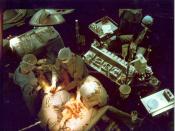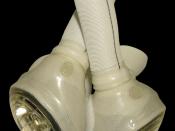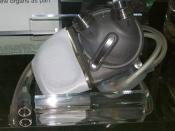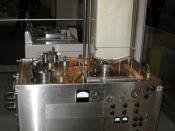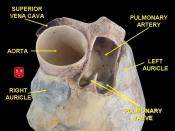The artificial heart is a very complex machine and with it comes a very complex procedure to install it in the patient. The surgery takes about 7 hours to complete and the surgeons require many support staff in order to successfully implant the heart into the patient.
Firstly the surgeons and support staff sanitize all instrument and hands. The body's biggest layer of protection from pathogens and other microbes is the skin. When a patient is being implanted with a new heart the skin must be cut so that the heart can be implanted. When the skin is cut this layer of protection, the skin, is cut it reduces the effectiveness of the protection and is more prone to infection. Infection is when outside germs enter the body through a cut or another means of bypassing the body's natural protection and causes some potentially life threaten actions, this could even cause the new implant to be compromised and reduce the new hearts effectiveness.
When doctors sterilize their equipment and their hands they are destroying the germs and microbes present on their equipment and hands. This dramatically reduces the chance of post operation infection for the patient. That is why sterilization is a very crucial step in installing the artificial heart.
Then, surgeons implant the artificial heart's wireless energy coil into the abdomen. This will provide the electricity that the artificial heart needs to operate and a way for the patient to recharge the temporary batteries fitted so that they can detach their main power supply for about 30-40 minutes so they can, for example, have a shower.
Then the surgeons open the patient's breast bone and attach a heart-lung bypass to the patient while the doctors operate on the natural heart. A heart-lung machine is installed on the patient to mimic the functions of the heart and lungs. This machine pumps blood around the patient's body and re-oxygenates the red blood cells thus keeping the patient alive during the surgery. If the patient was not on a heart-lung machine then their body cells would die from oxygen starvation because the body has no way of circulating the blood to the lungs for it to be re-oxygenated. This is crucial as the patient would die if their blood was not circulated around the body while the artificial heart was being installed. The heart-lung machine allows the surgeons to fully install the artificial heart and keep the patient alive without this the patient would die as blood can not be circulated around the body because the body's natural pump, the heart, is being removed. The surgeons cut, extremely carefully, out only the left and right ventricles of the natural heart and leave the right and left atria, the aorta and the pulmonary artery because in heart failure it is only the ventricles that fail the atria and aorta and pulmonary artery are not damaged.
Surgeons now cut to an appropriate length of graft and sew to the aorta and pulmonary artery. This is to extend and expand the diameter of the aorta and pulmonary artery so that it can fit on the artificial heart.
The artificial heart is then connected to the left and right atria, aorta and pulmonary artery. This is a crucial step. Surgeons must be careful not to damage the delicate parts of the natural heart that are still left in the patent as this could be life threatening. The Artificial heart is implanted by a sort of "Quick-connect" which clip on to the atria, aorta and pulmonary artery.
The artificial heart is now installed and all the air inside of it is removed by a vacuum. This is important because if the air stayed in the heart and was pumped around the body the patient would die instantly because the air bubble in the artificial heart is big and would cause an Embolism, a blockage caused by an object that has migrated from one part of the body to another. The veins in the brain are very small so a air bubble could get lodged into them and cause cellular death by oxygen deprivation. When the air bubble is circulated around the body it will eventually return to the heart and when it enters the ventricles it will cause a loss in pressure in the chambers of the heart. This will cause an arrhythmia, irregular heart beats. This is a huge problem because the re-oxygenated blood cannot get to the body cells and the cells die from oxygen starvation. The vacuuming of the chambers is a very important step in implanting the artificial heat.
The artificial heart is "flooded" with blood and turned on. If all works well then the heart lung machine is turned off and the bypass is removed from the patient and the surgeons close the breast bone and stitch the cuts so that the skin can heal.
This procedure takes approximately 7 hours to complete because of its complexity.
References:http://health.howstuffworks.com/artificial-heart2.htm
